January 2019
Dear Friends,
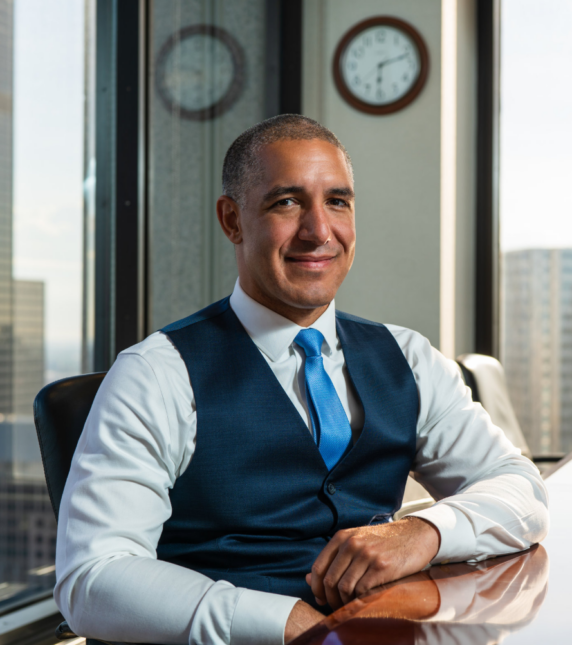
“Chicago has already proven that we can defy the odds in terms of educating our highest need students. Now we need to show we can do it for all students.”
In 2015, we set out to change the dynamic around school reform in Chicago by creating a new parent- and community-centered approach fueled by data analysis around school quality.
Putting parent voices at the center of our work has become the manifesto for how our organization approaches education policy change.
We bring families and the district to the same table—to make decisions together, creating data-driven, kids-first policies that address systemic barriers to a high-quality education.
Our latest analysis of CPS’ quality ratings shows that the district has steadily improved since 2015—but the pace of change is slow, and additional challenges lie ahead. Enrollment in CPS has been shrinking for almost a decade and that trend shows no signs of slowing down. At the same time, there are significant programmatic and choice trends across CPS that require deeper exploration.
Much more complicated work lies ahead, but we’re committed to partnering with our communities and the district to accelerate the progress underway.
Chicago has already proven that we can defy the odds in terms of educating our highest-need students—now we need to show we can do it for all students.
We invite you to celebrate our accomplishments in the pages following and thank you in advance for your continuing partnership.
Best,
Daniel Anello
CEO, Kids First Chicago
26,000
8th Grade Students Provided With Better Access to High School via One Single Application—GOCPS
10,000+
Parents, Students & Community Members Engaged by Kids First Chicago
1st Ever
Annual Regional Analysis, on School Quality, Choice/Enrollment Patterns, & Program Offerings of CPS
33,000
Additional Students Enrolled in Higher-Quality Schools Since 2015
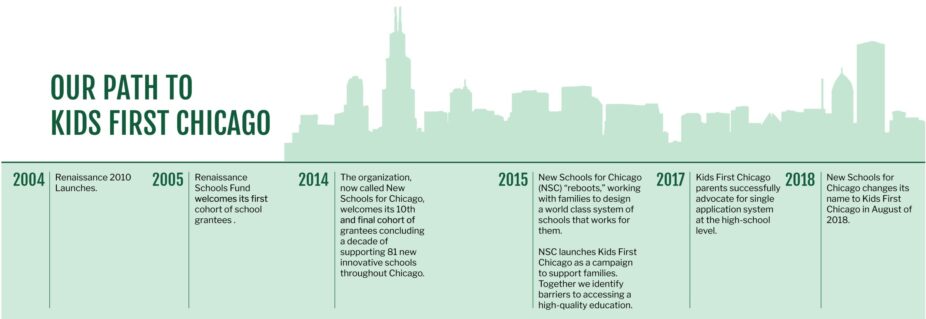
Our Evolution
In June 2004, Chicago Mayor Richard M. Daley, Chicago Public Schools (CPS) CEO Arne Duncan, and leaders from the Chicago business community announced the Renaissance 2010 initiative.
The goal was to open 100 new schools and provide all students, regardless of socio-economic background, with the opportunity to compete on the global playing field.
The Renaissance Schools Fund was established by the Civic Committee of the Commercial Club of Chicago as the independent fundraising and strategic partner to Renaissance 2010.
Our objective then, as now, was to catalyze dramatic improvement within CPS. At the time, only 50% of students graduated from high school, and low-income students of color were significantly more affected than their peers.
Initially supported with more than $20 million in seed funding, we led the collaborative public-private partnership that catalyzed new school creation and functioned as the accountability partner to CPS in the school selection process.
From 2004 to 2014, with the support of the city’s business community, philanthropists, educators, and innovators, we raised more than $100 million to start 81 new schools, inspiring the name New Schools for Chicago (NSC), which would contribute to an era of amazing educational gains.
Today, graduation rates are at an all-time high of 78%. Since our initial efforts, college readiness scores have increased significantly; and reading and math scores in elementary schools improved at rates that rank in the top of urban districts nationally.
Despite remarkable progress, in 2015 nearly 75,000 students remained in failing schools that were not preparing them for success in college, career, and life. We saw that our low-income communities with predominantly Black and Latine families were disproportionately affected—an inequity that demanded renewed attention.
At the same time, we recognized that the district now had an influx of quality options, coupled with a shrinking student population. These circumstances meant that opening new schools would no longer have the positive impact of the previous decade.
More importantly, Chicago’s historically top-down approach to education created better options for many but also had unintended consequences that drove a wedge between grass-tops and grassroots stakeholders.
We relaunched in 2015 with a new strategy to place parents at the heart of the conversation and to shift the narrative to focus on school quality, rather than simply new choices.
At the time, we developed Kids First Chicago (K1C) as a campaign to empower parents with the information to find the best schools for their children and to have a voice in shaping education policy to better serve all of Chicago’s children.
Over the past three years, we’ve garnered positive feedback as a trusted and unbiased source of information on education quality and school performance to both communities and district leadership.
To build on our rich legacy of improving access to high-quality schools in Chicago, while also recognizing the natural evolution of our work, in August 2018, Kids First Chicago became the new banner for all that we do.
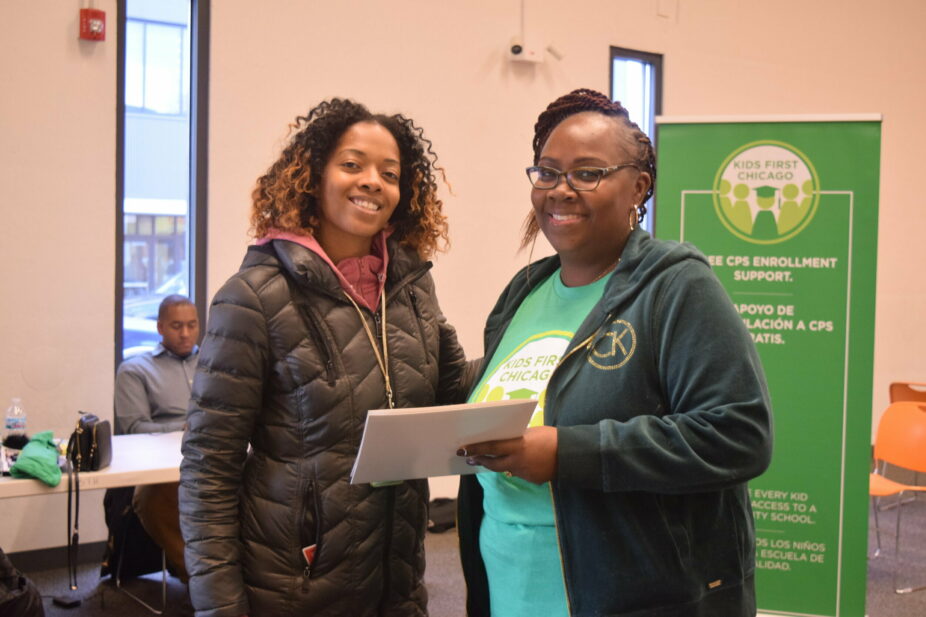
Our Approach
Facing Inequities With Human-Centered Design

Despite tremendous progress, Chicago’s public education system is still not equitable for all families. As our 2017 report Who is Sitting in Those Seats? highlighted, the number of children in “failing seats,” which do not prepare them for success in college, careers, or life, decreased from 161,531 in 2011 to 49,984 in 2017.
However, these “failing seats” are not shared equally—in fact, 1 in 4 Black students is in a “failing seat,” compared to 1 in 12 Latine and 1 in 50 White students.
We wrestle with these inequalities in our daily work. In order to eliminate disparities and ensure every child has access to a world-class education, our core strategies include:
- Empower communities and families to identify, navigate to, and advocate for high-quality public schools for their children and communities;
- With parent input, shape education policy and systems to better support communities and families; and
- Provide unbiased data expertise to communities and policymakers alike.
We take a human-centered, design-thinking approach to implementing our core strategies.
First, we listen and understand by engaging with parents through a variety of methods. Then, we engage in comprehensive data analysis and use that information, along with parent input, to concretely define barriers.
Once we’ve outlined barriers, we bring parents and district leaders to the table to design solutions—together. We pursue the changes that will ensure:
- Equal and fair access to schools
- Adequate and equitable funding for students
- Transparent information on quality, budgets, and decision-making
We then implement and refine those solutions over time. We monitor impact by analyzing data and soliciting parent feedback at every stage. This approach is powerful in improving education.
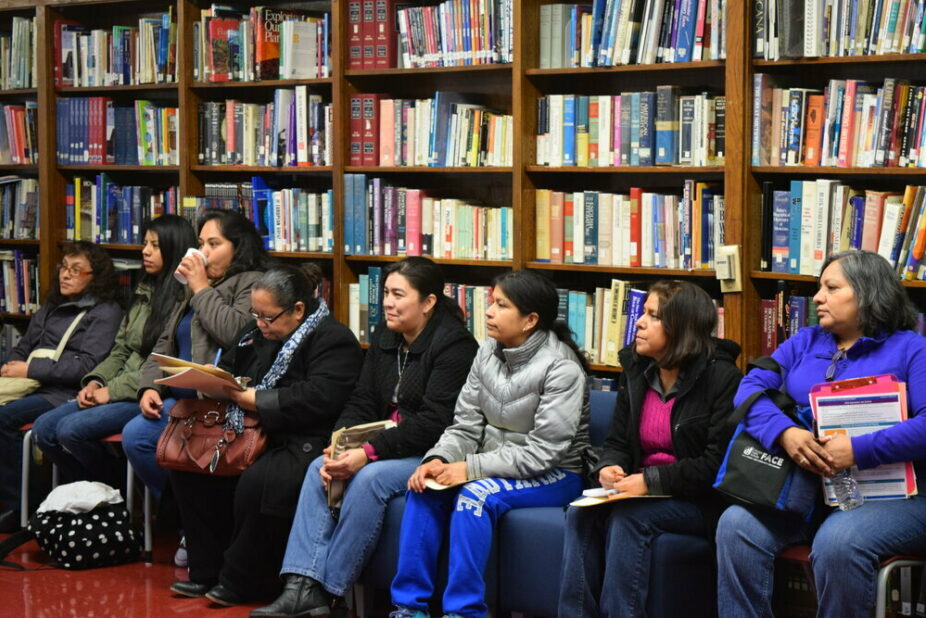
A Powerful Example of Our Work in Action
Universal Enrollment

Parents gather for free enrollment support.
In 2015, we began extensive engagement with families to understand their primary pain-points in education.
We heard overwhelmingly that Chicago’s school enrollment process was “broken” for families. With hundreds of applications for programs and schools, the system favored parents with the time, resources, networks, and experience to overcome enrollment barriers.
In conversations with CPS, we heard that the process was also “broken” from its perspective. It did not provide timely, efficient, or actionable data for the district and school leadership.
Without a fix, the district struggled to make informed decisions around school and program offerings, while principals couldn’t set budgets in time for school to start.
Many families struggled to find a school as late as October—well into the academic year.
Our response to tackle the broken process illustrates our core organizational strengths. We:
- Sought out national expertise;
- Researched and produced recommendations for district leadership;
- Provided transparent, digestible information to parents;
- Activated parent voices in advocating for change;
- Offered trainings for schools and community-based partners; and
- Provided direct project management support for CPS.

I never knew about an enrollment process. In high school, I just went to the neighborhood high school. I just didn’t know there were a lot of options for different types of schools—charter, public, etc. Some parents are lost. They Don’t know where to start.
—Focus Group Parent
Elevating Parent Voice
In January of 2017, we enlisted the expertise of the Institute for Innovation and Public School Choice (IIPSC) and organized 10 focus groups with CPS parents from across the city. IIPSC released a summary of findings from these sessions and shared feedback with the district.
KEY FINDINGS
- Families were not getting enough information about schools and programs, and so could not adequately participate in the process of selecting schools and programs.
- The act of applying to schools and programs in Chicago was cumbersome and complicated.
- Parents were uncomfortable with the way choice results were determined and communicated. They wanted better and more reliable communication, explanations for results, and more information and a clear set of rules to follow regarding waitlists.
- Parents supported a Universal Application and a single-best-offer process for allocating seats.
In April 2017, the Chicago Board of Education voted unanimously in favor of moving to a single application for all public high schools in the city.
Kids First Chicago parent and community advocates attended the board meeting to lend their voices in support of this kids-first policy change and to deliver the petitions of parents who could not attend.
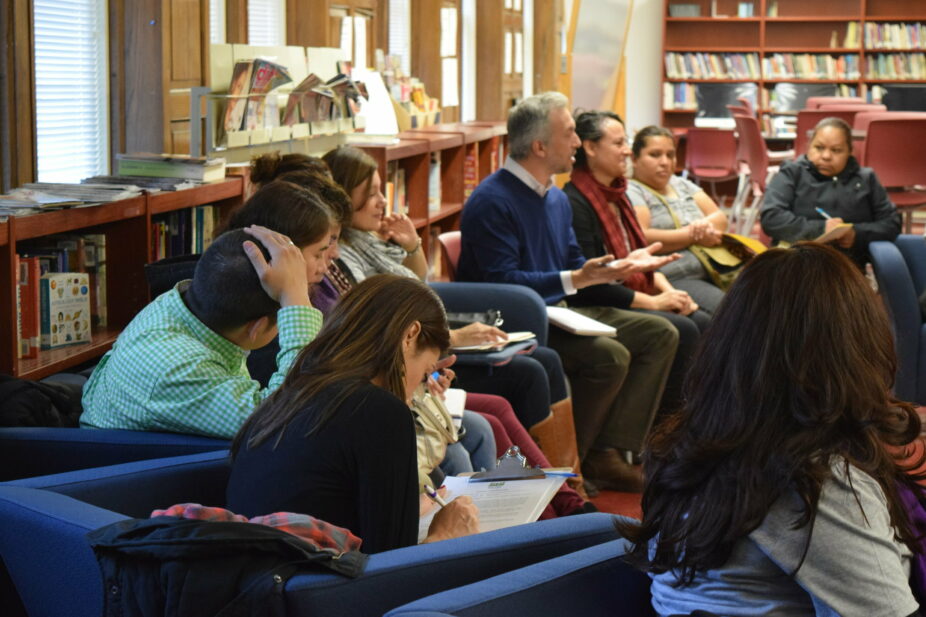
26,000
Students With Better Access
93%
Participation Rate
80%
Match Rate
Year One Process & Results
In the 2017-18 school year, the shift to a single application platform, called GoCPS, at the high school level resulted in a 93% application rate and provided more than 26,000 students with more transparent and fair access to high-quality schools across the district. This participation rate is record-breaking for urban districts nationally.
According to a 2018 study from the University of Chicago Consortium on School Research and the Federal Reserve Bank, more than 80% of students who used GoCPS in Year One received an offer at one of their top three highest-ranked schools. In focus groups, parents overwhelmingly described GoCPS as “easy” or “easier.”
We continue to gather and respond to parent feedback about the new enrollment system. We conducted nine focus groups with 65 parents of CPS 8th graders across the city to better understand what parents liked and disliked and how we can best support families through the new process. We compiled their feedback into a new report, Parents Talk GoCPS.
Looking ahead, we will work with CPS to refine the high school application process, ensuring any families’ concerns from Year One are addressed and that participation rates among students remain high in the 2018-2019 school year and beyond.
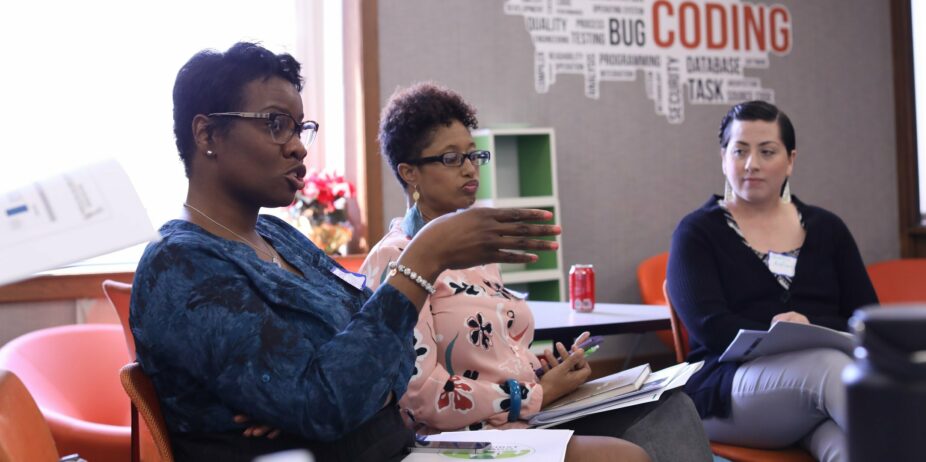

I became involved with Kids First Chicago simply trying to research and figure out the whole CPS system and how it works, and where I was going to find a place for my daughter. I’m very much a person that likes data and it was extremely eye-opening for me. As a parent, I plan to continue to be involved in order to make those positive changes. There just needs to be this equal amount of opportunity and access regardless of where you live. It’s great to be able to connect with like-minded people, and that we’re all here for education and we’re all here for kids.
—Heather Arellano CPS Parent & Attendee of Kids First Chicago ARA Briefing
Chicago’s Inaugural Annual Regional Analysis
Making Data Available & Understood
Chicago students and families struggle not only to find basic information about our schools, but also to understand the implications on their students’ education. Without digestible, accurate information, families are often left out of the decision-making process when it comes to schools.
We partnered with CPS to create a first-of-its-kind, comprehensive fact base called the Annual Regional Analysis (ARA).
It is a consistent set of information on enrollment, student demographics, school quality, school choice, and program offerings for all students in all public schools, organized by region.
In developing the ARA, CPS needed an independent intermediary that could undertake comprehensive analysis to uncover barriers to quality and access, build knowledge and capacity of grassroots stakeholders, and create a model for community-driven school planning that can be replicated in other neighborhoods/regions served by CPS.
Kids First Chicago is uniquely positioned to serve in this intermediary role because of our track record of effectively engaging family and community stakeholders to support high-impact district policy change.
In 2018, we briefed more than 120 organizational partners on the ARA.
Guided in part by the briefings that our team facilitated, CPS hosted ARA town halls in each of the 16 regions of the city in the fall of 2018.
These briefings demonstrate a commitment to open dialogue between district leadership, schools, and community residents, and are a proof point that the ARA is working exactly as intended — to bridge the gap between grass-tops and grassroots stakeholders in creating solutions to our city’s most pressing education challenges.
This new resource has already guided strategic decision-making and investments by the district and dozens of other external education partners. We produced a User Guide to help stakeholders digest and apply the ARA to communities and schools.

Kids First Chicago has given so much support to Clark and our community, and they’ve provided technical guidance so we could take advantage of opportunities to improve our school and our neighborhood. They are dedicated to making sure community voices are heard and listened to. We are so glad to count them as a partner.
—Charles Anderson Principal, Michele Clark High School on Chicago’s West Side
Using the ARA Guide Strategy
According to the analysis, there are nearly 50,000 available elementary school seats in CPS’s highest-quality-rated schools.
Nearly 15,000 of these available seats are in 52 high-performing elementary schools in underserved neighborhoods on Chicago’s West and South Sides. A new strategic priority for Kids First Chicago is to support families of elementary school children in navigating to available high-quality options, while diving deeper to understand and address the obstacles that have contributed to these “empty” quality seats in the first place.
In the analysis of ARA data, the West Side has emerged as a microcosm of the broader issues facing the district. The West Side is a historically underinvested, low-income, high-minority region of the city serving as many students as the entire Cleveland Public School system, for example. Fewer than half of students in both elementary and high school on the West Side attend a Level 1+/1 school.
However, there are almost 10,000 unfilled Level 1+/1 elementary seats in the West Side Region alone. With this data in mind, we have made it a strategic priority for K1C to better understand the choices of families whose students attend low-quality schools in this area.
In partnership with families and community organizations in the West Side neighborhoods of Austin, North Lawndale, East Garfield Park, West Garfield Park, and Humboldt Park, we are helping families advocate for new investments based on data from the ARA, conducting additional fact-finding through polling and focus groups to understand families’ school choices, and continuing to empower families and community stakeholders through direct service and information-sharing. In the long term, we hope this revitalization will extend beyond the education space, achieving multi-sector solutions to empower West Side champions and promote sustainable change in the region.

Measuring Progress in Chicago Public Schools

Kids First Chicago with parents and community volunteers at an enrollment workshop.
At Kids First Chicago, we believe that a fair and transparent method of measuring school quality is critical to making school choice work for families. Families cannot make informed choices about schools without a consistent “measuring stick” for whether students in a school are learning.
To measure districtwide progress, we rely on the same measure that CPS uses to measure the quality of every public school in the district–the School Quality Rating Policy (SQRP). We analyze quality over a 2-year average to understand if schools are maintaining strong performance over time. Measuring the consistency of a school’s activity over time provides a more accurate depiction of that school’s performance.
We believe that measurements of school quality should be applied consistently across all types of schools and that school quality levels should be communicated and made easily accessible to families. Yet, we recognize that SQRP is only one of many factors that families use when making decisions about school options.
In aggregate, we look at the breadth of all schools’ performance from year to year to better understand whether the district is providing a quality education for all students.
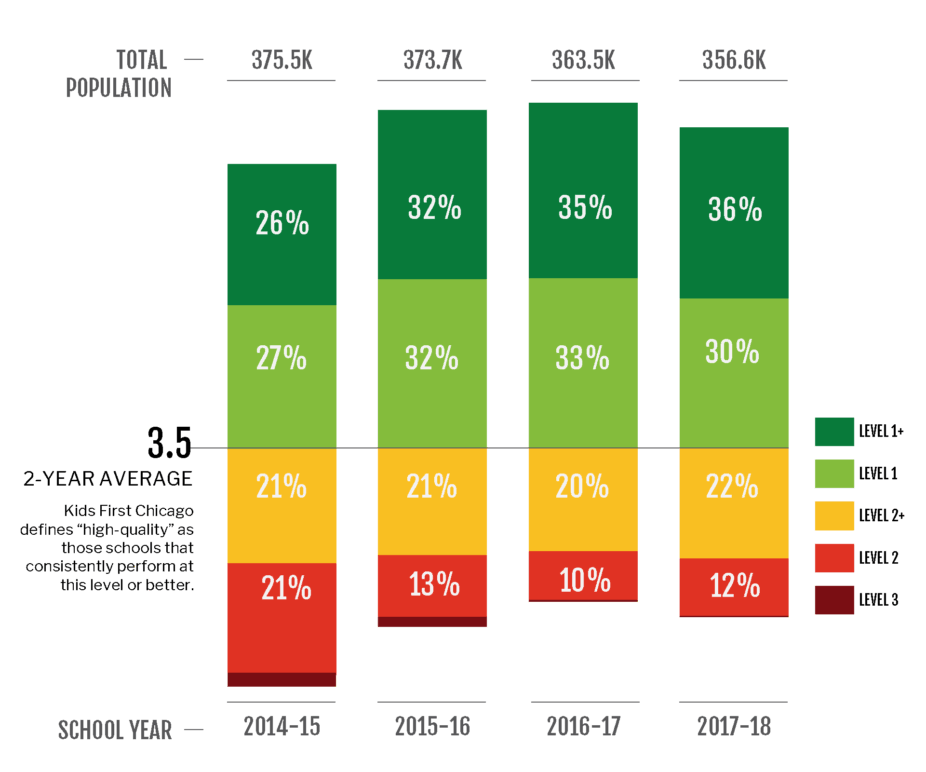
Understanding School Quality Over Time
When we compare the 2-year average SQRP scores of all schools' performance across the district, we see that from School Years 2014-15 to 2017-18 district performance has steadily improved.
While the lowest-performing schools (Level 2 and 3) have been addressed over time, the proportion of middle-performing schools (Level 2+) remains relatively stagnant.
At the time of our organizational relaunch, there were 75,000 students enrolled in Chicago’s lowest-performing schools. In our 2016 Impact Report, we shared that that number had been reduced to approximately 50,000 and now we see it further decreased to around 42,000.
Improving Mid-Performing Schools
Since 2015, we have partnered with the following schools on school improvement: EPIC Academy, Perspectives, Madison Elementary, Foundations College Prep, CICS ChicagoQuest, and Northwest Middle School.
Our analysis shows that there are more than 75,000 kids in mid-performing schools with a 2-year average of Level 2+. Unfortunately, these mid-performers are often overlooked as the district and other partners focus on the lowest performers with more severe challenges—and fewer students. We believe that the return on investment for a strategy to improve middle-performing schools for CPS is likely to be far greater than turnaround strategies and more viable than opening new high-performing schools in a district with significant enrollment challenges.
In the years ahead, we will pursue expanded school improvement research aimed at finding exemplary schools, understanding how they are structured for continuous improvement, and helping mid-performing schools apply best practices to catalyze improvements within their schools.

